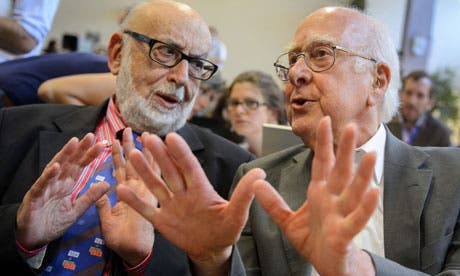
Just a few moments ago, the Royal Swedish Academy of Sciences awarded this year’s Nobel Prize in Physics to Francois Englert and Peter Higgs on Tuesday for their 1964 postulation of the existence of the Higgs boson. The elementary particle was finally confirmed in 2012 by a team of international researchers using the Large Hadron Collider at CERN.
The July 2012 discovery of the particle in the most powerful particle accelerator in the world, the Large Hadron Collider near Geneva, Switzerland, has been billed as one of the biggest scientific achievements of the last 50 years. The Higgs boson, also sometimes referred to as the God particle, is thought to be the elementary particle responsible for granting all matter with mass. It’s become obvious now how monumental this discovery is.
But why not last year? In 2012 everybody was expecting Englert and Higgs to win the physics prize, but instead the award went to two scientists (Haroche and Wineland ) for their work with light and matter, which may lead the way to superfast quantum computing and the most precise clocks ever seen. The Royal Swedish Academy of Sciences often steers away from scientific premiers and chooses to opt for more mature research. This year, however, it was clear than Englert and Higgs shouldn’t be missed.
Swedish industrialist Alfred Nobel created the prizes in 1895 to honor work in physics, chemistry, literature and peace. Since 1901, the committee has handed out the Nobel Prize in physics 106 times. The youngest recipient was Lawrence Bragg, who won in 1915 at the age of 25. For the 2013 awards, so far the Nobel Prize in Physiology or Medicine has been announced: James E Rothman, Randy W Schekman and Thomas C Südhof for their work on the mechanism that controls the transport of membrane-bound parcels or ‘vesicles’ through cells.






